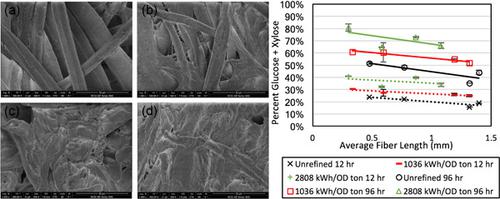当前位置:
X-MOL 学术
›
Biotechnol. Bioeng.
›
论文详情
Our official English website, www.x-mol.net, welcomes your
feedback! (Note: you will need to create a separate account there.)
Fiber fractionation to understand the effect of mechanical refining on fiber structure and resulting enzymatic digestibility of biomass.
Biotechnology and Bioengineering ( IF 3.5 ) Pub Date : 2020-01-13 , DOI: 10.1002/bit.27258 Derek B Corbett 1 , Charlie Knoll 1 , Richard Venditti 1 , Hasan Jameel 1 , Sunkyu Park 1
Biotechnology and Bioengineering ( IF 3.5 ) Pub Date : 2020-01-13 , DOI: 10.1002/bit.27258 Derek B Corbett 1 , Charlie Knoll 1 , Richard Venditti 1 , Hasan Jameel 1 , Sunkyu Park 1
Affiliation

|
Mechanical refining results in fiber deconstruction and modifications that enhance enzyme accessibility to carbohydrates. Further understanding of the morphological changes occurring to biomass during mechanical refining and the impacts of these changes on enzymatic digestibility is necessary to maximize yields and reduce energy consumption. Although the degree of fiber length reduction relative to fibrillation/delamination can be impacted by manipulating refining variables, mechanical refining of any type (PFI, disk, and valley beater) typically results in both phenomena. Separating the two is not straightforward. In this study, fiber fractionation based on particle size performed after mechanical refining of high‐lignin pulp was utilized to successfully elucidate the relative impact of fibrillation/delamination and fiber cutting phenomena during mechanical refining. Compositional analysis showed that fines contain significantly more lignin than larger size fractions. Enzymatic hydrolysis results indicated that within fractions of uniform fiber length, fibrillation/delamination due to mechanical refining increased enzymatic conversion by 20–30 percentage points. Changes in fiber length had little effect on digestibility for fibers longer than ~0.5 mm. However, the digestibility of the fines fractions was high for all levels of refining even with the high‐lignin content.
中文翻译:

纤维分馏以了解机械精制对纤维结构的影响以及生物质的酶消化率。
机械精制导致纤维解构和修饰,从而增强了酶对碳水化合物的可及性。必须进一步了解机械精炼过程中生物质发生的形态变化以及这些变化对酶消化率的影响,才能最大程度地提高产量并减少能耗。尽管可以通过控制精炼变量来影响相对于原纤化/分层的纤维长度减少程度,但任何类型(PFI,盘式和谷形打浆机)的机械精炼通常都会导致这两种现象。将两者分开并不容易。在这个研究中,在对高木质素纸浆进行机械精制后,根据粒度进行的纤维分级可成功地阐明机械精制过程中原纤化/分层和纤维切割现象的相对影响。成分分析表明,细粉中所含的木质素要比较大的部分要大得多。酶促水解的结果表明,在纤维长度均匀的部分内,由于机械精制而产生的原纤化/分层增加了20-30个百分点的酶促转化。纤维长度的变化对大于〜0.5 mm的纤维的消化率影响很小。但是,即使木质素含量很高,细粉馏分的消化率在所有精炼水平上都很高。成分分析表明,细粉所含的木质素要比较大尺寸的细粉要多得多。酶促水解的结果表明,在纤维长度均匀的部分内,由于机械精制而产生的原纤化/分层增加了20-30个百分点的酶促转化。纤维长度的变化对大于〜0.5 mm的纤维的消化率影响很小。但是,即使木质素含量很高,细粉馏分的消化率在所有精炼水平上都很高。成分分析表明,细粉所含的木质素要比较大尺寸的细粉要多得多。酶促水解的结果表明,在纤维长度均匀的部分内,由于机械精制而产生的原纤化/分层增加了20-30个百分点的酶促转化。纤维长度的变化对大于〜0.5 mm的纤维的消化率影响很小。但是,即使木质素含量很高,细粉馏分的消化率在所有精炼水平上都很高。
更新日期:2020-03-09
中文翻译:

纤维分馏以了解机械精制对纤维结构的影响以及生物质的酶消化率。
机械精制导致纤维解构和修饰,从而增强了酶对碳水化合物的可及性。必须进一步了解机械精炼过程中生物质发生的形态变化以及这些变化对酶消化率的影响,才能最大程度地提高产量并减少能耗。尽管可以通过控制精炼变量来影响相对于原纤化/分层的纤维长度减少程度,但任何类型(PFI,盘式和谷形打浆机)的机械精炼通常都会导致这两种现象。将两者分开并不容易。在这个研究中,在对高木质素纸浆进行机械精制后,根据粒度进行的纤维分级可成功地阐明机械精制过程中原纤化/分层和纤维切割现象的相对影响。成分分析表明,细粉中所含的木质素要比较大的部分要大得多。酶促水解的结果表明,在纤维长度均匀的部分内,由于机械精制而产生的原纤化/分层增加了20-30个百分点的酶促转化。纤维长度的变化对大于〜0.5 mm的纤维的消化率影响很小。但是,即使木质素含量很高,细粉馏分的消化率在所有精炼水平上都很高。成分分析表明,细粉所含的木质素要比较大尺寸的细粉要多得多。酶促水解的结果表明,在纤维长度均匀的部分内,由于机械精制而产生的原纤化/分层增加了20-30个百分点的酶促转化。纤维长度的变化对大于〜0.5 mm的纤维的消化率影响很小。但是,即使木质素含量很高,细粉馏分的消化率在所有精炼水平上都很高。成分分析表明,细粉所含的木质素要比较大尺寸的细粉要多得多。酶促水解的结果表明,在纤维长度均匀的部分内,由于机械精制而产生的原纤化/分层增加了20-30个百分点的酶促转化。纤维长度的变化对大于〜0.5 mm的纤维的消化率影响很小。但是,即使木质素含量很高,细粉馏分的消化率在所有精炼水平上都很高。











































 京公网安备 11010802027423号
京公网安备 11010802027423号